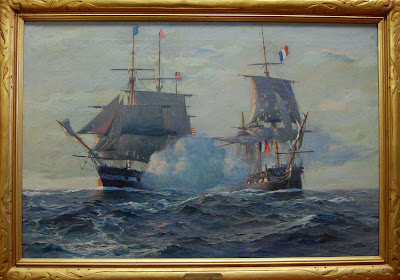Patriotism or Opportunity? Naval Recruits in Newport During the First World War
Naval Training Station Newport was already a busy place when
the United States entered the First World War on April 6, 1917. The base operated
schools for yeomen, signalmen, hospital corpsmen, commissarymen, musicians, and
firemen, as well as a preparatory school for the Naval Academy. On the eve of
war, approximately 2,000 recruits lived and trained on Coasters Harbor Island
at any given time. That number swelled to over 10,000 following the American
declaration of war against Germany. This massive influx of men and women
required new housing, training facilities, and infrastructure for the base.
Almost overnight, two new training areas named Camp Palmer and Camp Sadler
sprang up on Coasters Harbor Island. Tents, temporary barracks, mess halls, and
auxiliary buildings filled almost every available piece of open ground. When no
more room was left, the Navy bought 161 acres on Coddington Point and began
expanding toward Middletown.
 |
The Newport Recruit, vol. 1 no. 4
Box 2, News Collection 9
Naval Historical Collection, U.S. Naval War College
|
The base newspaper, The
Newport Recruit, included an editorial in the April 1917 edition that
reflected on the chain of events that had brought the country to the brink of
war (it was published one day before the United States entered the conflict),
beginning with President Wilson’s decision to maintain U.S. neutrality when
fighting first broke out in Europe:
We saw treaties violated, international
law defied, and neutral rights utterly disregarded; we saw truth, and justice,
and fairplay outraged, we saw blockades instituted that were as illegal as they
were indefensible, mines strewn upon the high seas in defiance of every rule of
war, submarines let loose to do their will, and all the hideous nightmares of
inhumanity which followed when belligerent outvied belligerent in the ghastly
work of retaliation.
One month later, the editors commented on the influx of new
trainees pouring into Newport. Though the Selective Service Act of 1917 required
all men between the ages of 21 and 30 to register for military service, the
editors noted that the imposition of the draft did not seem to be lowering the
quality of recruits who arrived at the Training Station:
We are getting the finest and the
best of our young manhood, but we are delighted to find that the people’s
representatives have seen fit to recognize the fact that citizenship has its
responsibilities as well as its privileges and that the first and most vital of
these is the duty of National Defense.
 |
Physical training at Naval Station Newport, c. 1915
Naval War College Museum Collection
|
It is interesting to contrast their observations with those
made just one year earlier. An editorial in the April 1916 edition of The Newport Recruit complained that in
the articles submitted to the newspaper for publication, sailors usually mentioned
the educational, physical, and financial benefits of joining the Navy as among
their reasons for enlisting. Few, however, cited patriotism as a motive. The
editors wondered aloud if the young men of that generation were too
materialistic to make good sailors.
Now we don’t for one moment suppose
that these young men are unpatriotic, but we do believe that material
considerations have so weaned them from an unselfish point of view that
patriotism instead of being the compelling impulse behind their interest in the
Navy, is merely a secondary issue.
They are more concerned with pay,
opportunities of advancement, opportunities of travel, opportunities of
acquiring a trade, and opportunities of saving money, than they are in the
honor of being enrolled as first line defenders of the Flag. All this is so
close to the mercenary spirit, and so utterly divorced from the standard of
value which was dear to our fathers, that it is time to make a mild protest
against it.
They need not have worried. By the end of the First World
War, 65,000 sailors had graduated from the training schools in Newport. Many of
them went on to serve in the Atlantic Fleet where their duties included convoy
protection, anti-submarine patrols, and laying the North Sea mine barrage, a
defensive barrier intended to keep German U-boats out of the Atlantic. Their
success in carrying out these operations ensured that American troops reached
the front in Europe and contributed to the Allied victory in 1918.
Rob Doane
Curator, Naval War College Museum


Comments
Post a Comment